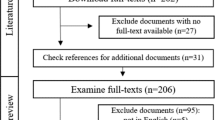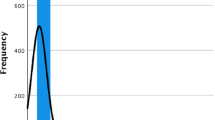Abstract
Altmetrics or other indicators for the impact of academic outputs are often correlated with citation counts in order to help assess their value. Nevertheless, there are no guidelines about how to assess the strengths of the correlations found. This is a problem because the correlation strength affects the conclusions that should be drawn. In response, this article uses experimental simulations to assess the correlation strengths to be expected under various different conditions. The results show that the correlation strength reflects not only the underlying degree of association but also the average magnitude of the numbers involved. Overall, the results suggest that due to the number of assumptions that must be made, in practice it will rarely be possible to make a realistic interpretation of the strength of a correlation coefficient.



Similar content being viewed by others
References
Ahlgren, P., & Waltman, L. (2014). The correlation between citation-based and expert-based assessments of publication channels: SNIP and SJR vs. Norwegian quality assessments. Journal of Informetrics, 8(4), 985–996.
Ajiferuke, I., & Famoye, F. (2015). Modelling count response variables in informetric studies: Comparison among count, linear, and lognormal regression models. Journal of Informetrics, 9(3), 499–513.
Bosquet, C., & Combes, P. P. (2013). Are academics who publish more also more cited? Individual determinants of publication and citation records. Scientometrics, 97(3), 831–857.
Brzezinski, M. (2015). Power laws in citation distributions: Evidence from Scopus. Scientometrics, 103(1), 213–228.
Chakraborty, T., Tammana, V., Ganguly, N., & Mukherjee, A. (2015). Understanding and modeling diverse scientific careers of researchers. Journal of Informetrics, 9(1), 69–78.
Clauset, A., Shalizi, C. R., & Newman, M. E. (2009). Power-law distributions in empirical data. SIAM Review, 51(4), 661–703.
Cohen, J. (1988). Statistical power analysis for the behavioral sciences (2nd ed.). Abingdon: Lawrence Erlbaum Associates.
Cohen, J. (1992). A power primer. Psychological Bulletin, 112(1), 155–159. doi:10.1037/0033-2909.112.1.155.
Cronbach, L. J. (1951). Coefficient alpha and the internal structure of tests. Psychometrika, 16(3), 297–334.
Didegah, F., & Thelwall, M. (2013). Which factors help authors produce the highest impact research? Collaboration, journal and document properties. Journal of Informetrics, 7(4), 861–873.
Ellis, P. D. (2010). The essential guide to effect sizes: Statistical power, meta-analysis, and the interpretation of research results. Cambridge: Cambridge University Press.
Else, H. (2015). Research funding formula tweaked after REF 2014 results. https://www.timeshighereducation.com/news/research-funding-formula-tweaked-after-ref-2014-results/2018685.article.
Eom, Y. H., & Fortunato, S. (2011). Characterizing and modeling citation dynamics. PLoS ONE, 6(9), e24926.
Ettori, S. (2015). The physics inside the scaling relations for X-ray galaxy clusters: Gas clumpiness, gas mass fraction and slope of the pressure profile. Monthly Notices of the Royal Astronomical Society, 446(3), 2629–2639.
Finardi, U. (2013). Correlation between journal impact factor and citation performance: An experimental study. Journal of Informetrics, 7(2), 357–370.
Franceschet, M., & Costantini, A. (2011). The first Italian research assessment exercise: A bibliometric perspective. Journal of Informetrics, 5(2), 275–291.
Garanina, O. S., & Romanovsky, M. Y. (2015). Citation distribution of individual scientist: Approximations of stretch exponential distribution with power law tails. In A. A. Salah, Y. Tonta, A. A. Akdag Salah, C. Sugimoto, & U. Al (Eds.), Proceedings of ISSI 2015 (pp. 272–277). Turkey: Bogaziçi University Printhouse.
Gillespie, C.S. (2015). Fitting heavy tailed distributions: the poweRlaw package. Journal of Statistical Software, 64(2), 1–16. http://www.jstatsoft.org/v64/i02/paper.
Hartley, J., & Sydes, M. (1997). Are structured abstracts easier to read than traditional ones? Journal of Research in Reading, 20(2), 122–136.
HEFCE. (2015). The metric tide: Correlation analysis of REF2014 scores and metrics. Supplementary Report II to the Independent review of the role of metrics in research assessment and management. Bristol: Hefce. http://www.hefce.ac.uk/pubs/rereports/Year/2015/metrictide/Title,104463,en.html.
Hemphill, J. F. (2003). Interpreting the magnitudes of correlation coefficients. American Psychologist, 58(1), 78–79.
Hirsch, J. E. (2005). An index to quantify an individual’s scientific research output. Proceedings of the National Academy of Sciences of the United States of America, 102(46), 16569–16572.
Hyland, K. (1999). Academic attribution: Citation and the construction of disciplinary knowledge. Applied Linguistics, 20(3), 341–367.
Kostoff, R. (2007). The difference between highly and poorly cited medical articles in the journal Lancet. Scientometrics, 72, 513–520.
Kousha, K., & Thelwall, M. (2015). Web indicators for research evaluation, part 3: Books and non-standard outputs. El Profesional de la Información, 24(6), 724–736. doi:10.3145/epi.2015.nov.04.
Larivière, V., & Gingras, Y. (2010). On the relationship between interdisciplinarity and scientific impact. Journal of the American Society for Information Science and Technology, 61, 126–131.
Limpert, E., Stahel, W. A., & Abbt, M. (2001). Lognormal distribution across sciences: Key and clues. BioScience, 51(5), 341–351.
Lipsey, M.W., Puzio, K., Yun, C., Hebert, M.A., Steinka-Fry, K., Cole, M.W., et al. (2012). Translating the statistical representation of the effects of education interventions into more readily interpretable forms. Washington, DC: US Dept of Education, National Center for Special Education Research, Institute of Education Sciences, NCSER 2013-3000.
Liu, G., Qi, X. L., Robert, N., Dick, A. J., & Wright, G. A. (2012). Ultrasound-guided identification of cardiac imaging windows. Medical Physics, 39(6), 3009–3018.
Low, W. J., Thelwall, M., & Wilson, P. (2015). Stopped sum models for citation data. In A. A. Salah, Y. Tonta, A. A. AkdagSalah, C. Sugimoto, & U. Al (Eds.), Proceedings of ISSI 2015 Istanbul: 15th international society of scientometrics and informetrics conference (pp. 184–194). Istanbul: Bogaziçi University Printhouse.
Mohammadi, E., & Thelwall, M. (2014). Mendeley readership altmetrics for the social sciences and humanities: Research evaluation and knowledge flows. Journal of the American Society for Information Science and Technology, 65(8), 1627–1638.
Onodera, N., & Yoshikane, F. (2015). Factors affecting citation rates of research articles. Journal of the Association for Information Science and Technology, 66(4), 739–764.
Oppenheim, C. (2000). Do patent citations count? In B. Cronin & H. B. Atkins (Eds.), The web of knowledge: A festschrift in honor of Eugene Garfield (pp. 405–432). Metford: Information Today Inc. ASIS Monograph Series.
Pennock, D. M., Flake, G. W., Lawrence, S., Glover, E. J., & Giles, C. L. (2002). Winners don’t take all: Characterizing the competition for links on the web. Proceedings of the National Academy of Sciences, 99(8), 5207–5211.
Persson, O., Glänzel, W., & Danell, R. (2004). Inflationary bibliometric values: The role of scientific collaboration and the need for relative indicators in evaluative studies. Scientometrics, 60(3), 421–432.
Radicchi, F., Fortunato, S., & Castellano, C. (2008). Universality of citation distributions: Toward an objective measure of scientific impact. Proceedings of the National Academy of Sciences, 105(45), 17268–17272.
Redner, S. (1998). How popular is your paper? An empirical study of the citation distribution. The European Physical Journal B-Condensed Matter and Complex Systems, 4(2), 131–134.
Sud, P., & Thelwall, M. (2014). Evaluating altmetrics. Scientometrics, 98(2), 1131–1143. doi:10.1007/s11192-013-1117-2.
Thelwall, M. (2006). Interpreting social science link analysis research: A theoretical framework. Journal of the American Society for Information Science and Technology, 57(1), 60–68.
Thelwall, M. (2016). The discretised lognormal and hooked power law distributions for complete citation data: Best options for modelling and regression. Journal of Informetrics, 10(2), 336–346. doi:10.1016/j.joi.2015.12.007.
Thelwall, M., & Fairclough, R. (2015). The influence of time and discipline on the magnitude of correlations between citation counts and quality scores. Journal of Informetrics, 9(3), 529–541. doi:10.1016/j.joi.2015.05.006.
Thelwall, M., & Kousha, K. (2015a). Web indicators for research evaluation, Part 1: Citations and links to academic articles from the web. El Profesional de la Información, 24(5), 587–606. doi:10.3145/epi.2015.sep.08.
Thelwall, M., & Kousha, K. (2015b). Web indicators for research evaluation, Part 2: Social media metrics. El Profesional de la Información, 24(5), 607–620. doi:10.3145/epi.2015.sep.09.
Thelwall, M., & Wilson, P. (2014). Distributions for cited articles from individual subjects and years. Journal of Informetrics, 8(4), 824–839.
Thelwall, M., & Wilson, P. (in press). Mendeley readership altmetrics for medical articles: An analysis of 45 fields. Journal of the Association for Information Science and Technology. doi:10.1002/asi.23501.
van Raan, A. (1998). The influence of international collaboration on the impact of research results: Some simple mathematical considerations concerning the role of self-citations. Scientometrics, 42(3), 423–428.
Wainer, J., & Vieira, P. (2013). Correlations between bibliometrics and peer evaluation for all disciplines: the evaluation of Brazilian scientists. Scientometrics, 96(2), 395–410.
Wilsdon, J., Allen, L., Belfiore, E., Campbell, P., Curry, S., Hill, S., et al. (2015). The metric tide: Report of the independent review of the role of metrics in research assessment and management. http://www.hefce.ac.uk/pubs/rereports/Year/2015/metrictide/Title,104463,en.html.
Author information
Authors and Affiliations
Corresponding author
Rights and permissions
About this article
Cite this article
Thelwall, M. Interpreting correlations between citation counts and other indicators. Scientometrics 108, 337–347 (2016). https://doi.org/10.1007/s11192-016-1973-7
Received:
Published:
Issue Date:
DOI: https://doi.org/10.1007/s11192-016-1973-7




